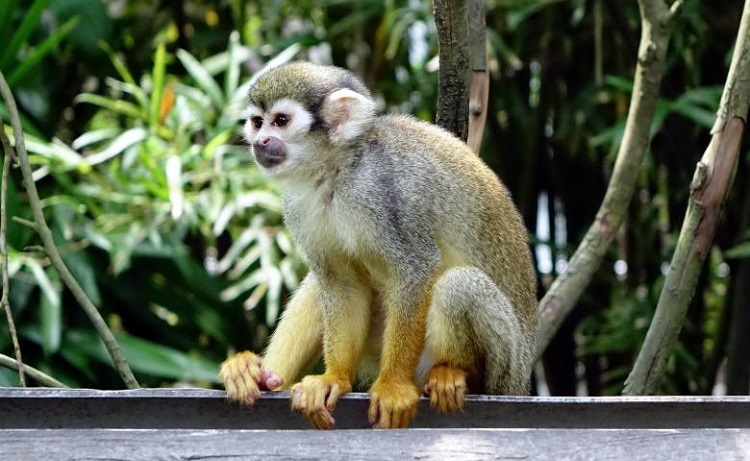Known as the Deaths Head monkey, the Squirrel monkeys belong to the family Cebidae. It is a small primate species with its natural habitat in the rainforests of South and Central America.
Besides a creepy death mask and false penises on females, this tiny primate can live in troops of 500 individuals. It has several other tricks up its sleeve, proving its big brain is as intelligent as scientists believe.
Read on to reveal the depths of this tiny dynamo.
About The Squirrel Monkey
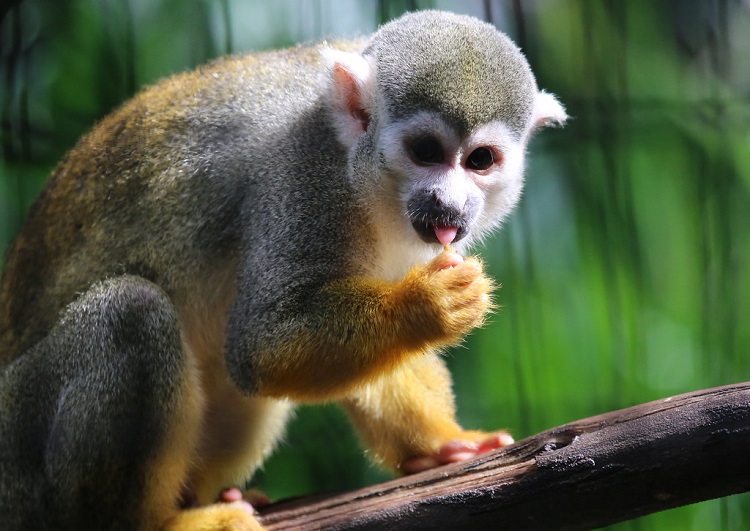
Squirrel monkeys are a part of the New World monkey species that inhabit South America. These Squirrel monkeys live and are native throughout Central and South America and Mexico and differ from Old World monkeys in several ways.
The New World monkeys are a lot smaller than the Old World monkeys.
They don’t have cheek pouches, and their tails are often prehensile, meaning they use them to grab onto tree branches. But, the Squirrel monkey’s tail is not prehensile, although it helps balance when climbing around the treetops of tropical forest canopies.
There are many other differences between the groups. One example is that New World monkeys, like Squirrel monkeys, are tree-dwelling (arboreal), whereas many (but not all) Old World monkeys spend more time on the ground than in trees.
The two main groups of these monkeys are distinguishable because of the shape of the white markings above their eyes. Some form subpopulations that evolve distinctly but still interbreed (parapatric speciation). This description fits the majority of the species.
Of the two groups of Squirrel monkeys, the other is an isolated biological population that no longer exchanges genes (allopatric). The S.oerstedii (Central American squirrel monkey) belongs to the second group and inhabits Panama and Costa Rica.
Besides Common Squirrel monkeys (Saimiri sciureus), other New World monkeys include Capuchin monkeys, Spider monkeys, and Howler monkeys.
Many of these primates are sold in the exotic pet trade or used for medical research.
Squirrel Monkey Taxonomy and Evolution
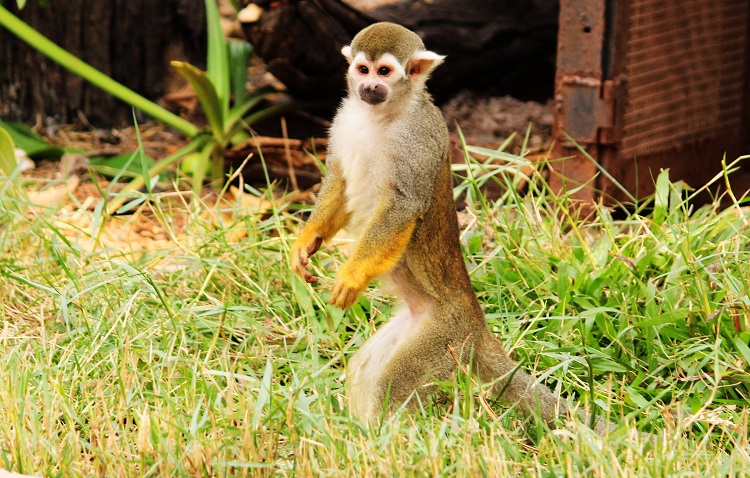
At first, researchers erroneously referred to this monkey as the common Squirrel monkey (Saimiri sciureus). Later, they realized that their description described three or four separate species.
The erroneous common Squirrel monkey species, which are distinct, are the following:
- Guianan squirrel monkey (Saimiri sciureus)
- Humboldt’s squirrel monkey (S. cassiquiarensis)
- Collins’ squirrel monkey (S. collinsi)
- Ecuadorian squirrel monkey (S. cassiquiarensis macrodon) – seen as a Humboldt subspecies or as a separate species
Besides, there are five species, which all look pretty similar, although with some distinguishing features.
Taxonomy
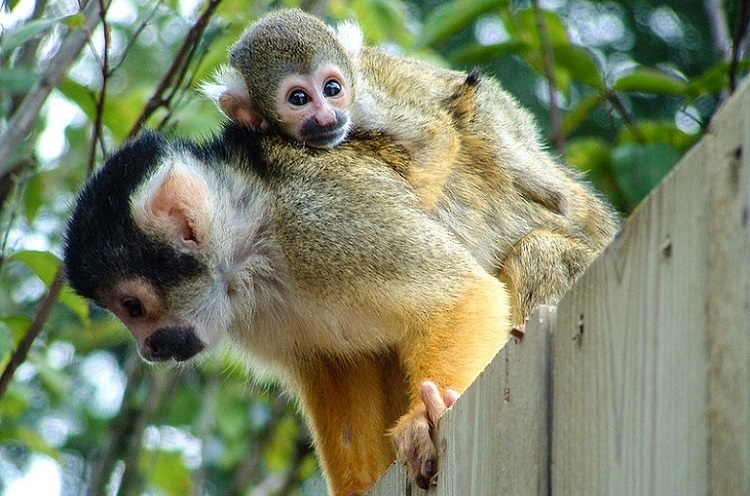
More recent scientific classifications of this animal classify the five species of Squirrel monkeys as the following:
- Black-capped squirrel monkey (Saimiri boliviensis)
- Central American squirrel monkey or Red-backed squirrel monkey (Saimiri oerstedii)
- Golden-backed squirrel monkey or Bare-eared squirrel monkey (Saimiri ustus)
- Black squirrel monkey or Blackish squirrel monkey (Saimiri vanzolinii)
- Guianan squirrel monkey (Saimiri sciureus)
There are also two species of squirrel monkeys that are extinct:
- Leventiana annectens or Saimiri annectens, also known as Neosaimiri annectenc
- Saimiri fieldsi
Scientific Classification
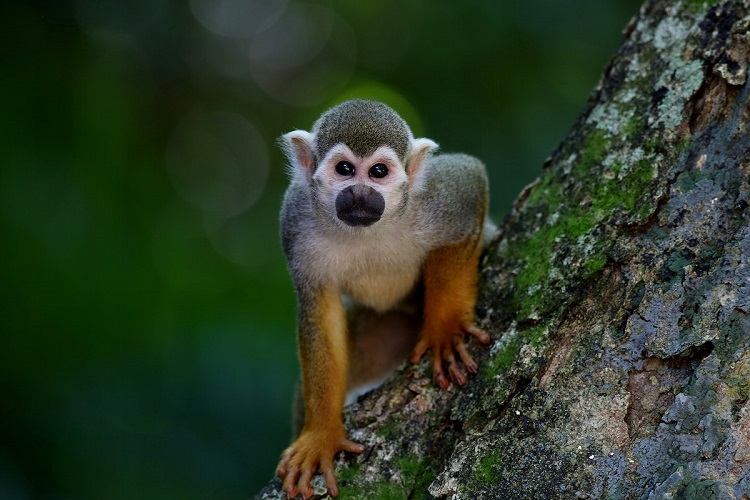
- Kingdom – Animalia
- Phylum – Chordata
- Class – Mammalia
- Order – Primates
- Suborder – Haplorhini
- Infraorder – Simiiformes
- Family – Cebidae
- Subfamily – Saimiriinae
- Genus – Saimiri
- Five Species: S. boliviensis, S. oerstedti, S. sciureus, S. ustus, S. vanzolinii
- Eight Subspecies: S. b. boliviensis, S. b. peruviensis, S. o. citrinellus, S. o. oerstedti, S. s. albigena, S. s. cassiquiarensis, S. s. macrodon, S. s. sciureus
Evolution
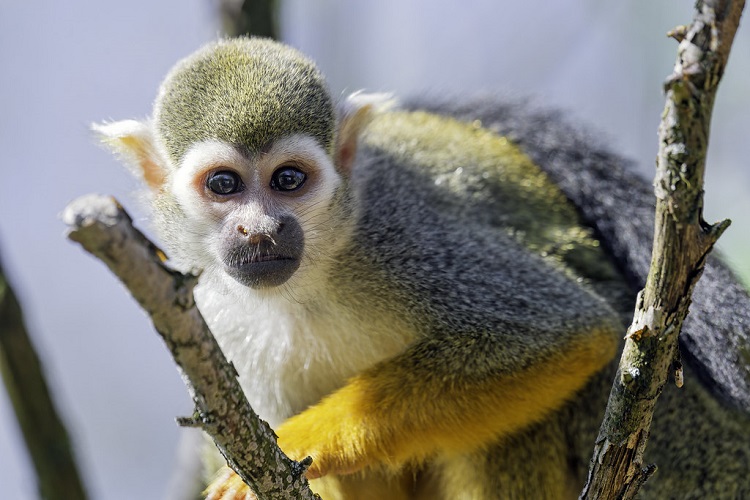
Researchers believe that the crown group of the existing squirrel monkeys split about 1.5 million years ago. This species then went through a period of diversification in the Pleistocene Epoch.
They don’t know how this monkey reached Central America but think that it did via human transport. Nevertheless, biologists think that the first species to diverge was S.boliviensis.
They have also established that S.s. sciureus and S.oerstedii are sister species and that S.s. macrodon is the sister species of the clade S.oerstedii and S.s. sciureus.
The information above shows that even scientists make mistakes. Biologists who study this primate realize and admit that they still need to do more work when it comes to classifying them accurately.
Physical Description
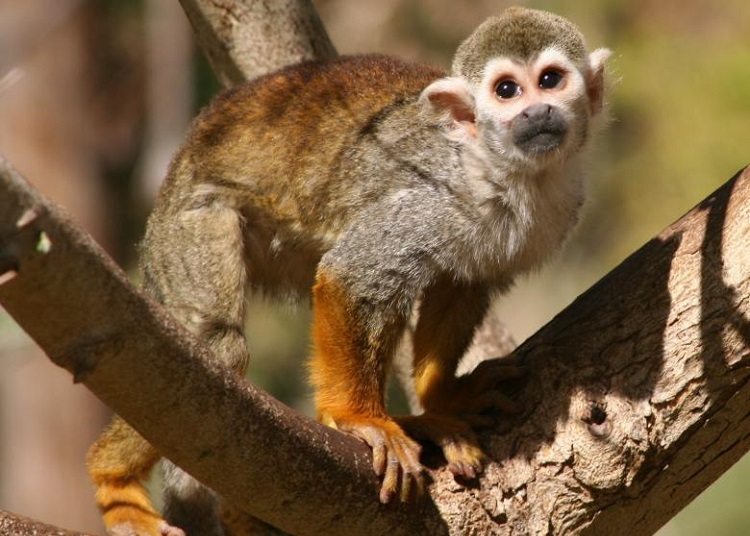
The average size of this tiny monkey ranges from 9.8 to 13.8 inches long. Its tail grows 14 to 17 inches long, making its total length as much as 30.8 inches. Male Squirrel monkeys weigh anything from 26 to 39 ounces, and female Squirrel monkeys weigh between 18 and 26 ounces.
Squirrel monkeys have dark noses and biggish pointed ears on round faces and furry heads. They have primarily white and black faces that create a mask around their eyes.
They are well known for this mask, which has earned them the nickname of the Deaths Head monkey due to its skull-like appearance. In other words, they look cute in daylight but could be creepy at night.
They have short, dense fur that lies close to the skin. It is mostly black on the shoulders but transforms into a yellowish-orange color on their backs and extremities.
Their tails are long and hairy. Both sexes have flat nails ending in sharp pointed claws. In summary, they’re cute but quite dangerous no matter their delicate frame and small size.
Squirrel Monkey Behavior and Ecology
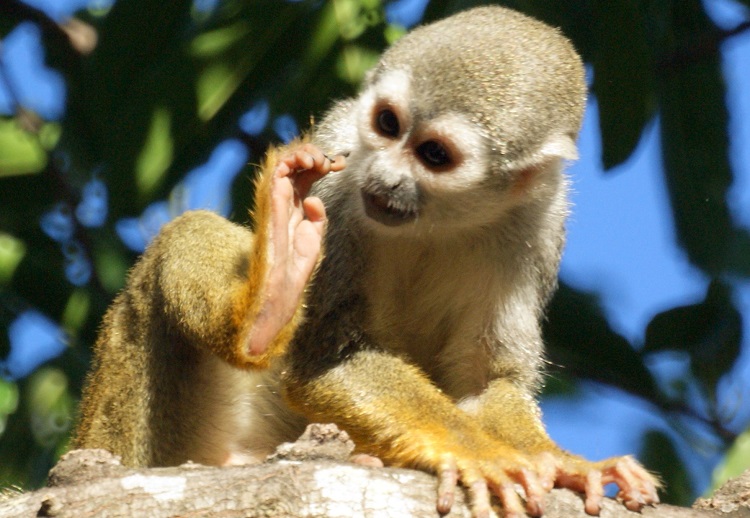
The secret life of monkeys in rainforests discusses how they regulate their temperatures, water and salt levels, and communication strategies. Other behaviors cover cooperation studies, colour vision, and reproduction.
Thermoregulation
These small animals must adjust their temperatures to maintain their health. They can only sweat through their hands and feet soles, so they must use other tactics to regulate their body temperature.
To cool down, they rest in shady trees and change their postures to ensure better cooling and dissipation of heat.
Another tactic is urine washing. They urinate in their hands and then rub this urine on the soles of their feet. As the urine dries, it also cools them. This method is vital for maintaining an ambient temperature.
Osmoregulation
Rain forests are intensely humid and hot. Humidity levels in the dry season are typically around 70%. In the rainy season, they soar to 90% saturation, where they can stay for long periods. Squirrel monkeys can tolerate saturation levels of 75%.
These animals must find other ways to keep their body temperature within safe parameters, especially when the humidity tips the scale at 95% in the wet season. Osmoregulation means maintaining the salt and water balance in their bodies or the osmotic balance.
Because water evaporation declines at elevated saturation levels, the Squirrel monkeys drink less water. In turn, this action makes their urine more concentrated. The result is that it helps osmoregulation by maintaining the desired moisture and ion levels internally. Clever!
Communication and Perception
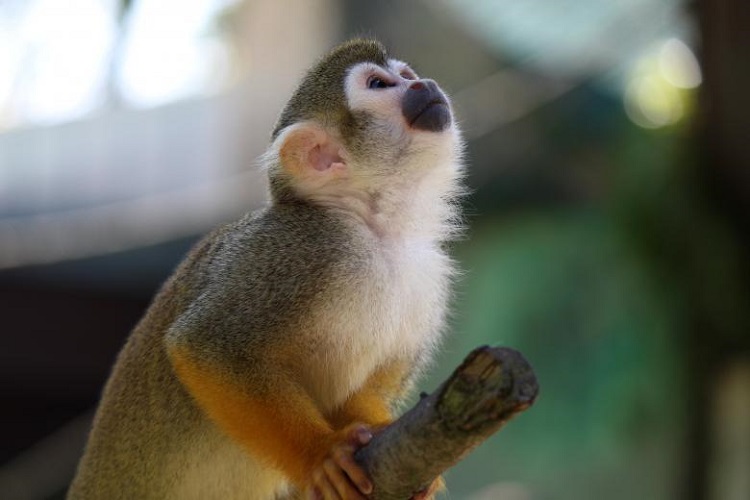
Communication between Squirrel monkeys takes place through vocal calls and non-verbal behavior. Oral communications in New World monkeys are as complex as in birds and humans. Squirrel monkeys use long calls to protect their territories, attract mates and display internal group unity.
Their sounds are also recognizable and perceived by individuals within subspecies and across species. These New World primates use basic syntax and take turns vocalizing.
Researchers also record that they are capable of meta-communication. This ability describes communicating in more than one form, such as body language and vocalization.
These expressions may coincide, reinforce, or contrast. Another way to say this is that they could be grinning while throwing poop. This behavior is passive-aggressive or showing you the middle finger, so to speak.
Body language consists of pulling tails, arching backs, showing their genitals, submissive huddles, play fighting, and actual fighting and ear wiggles.
They display other physical behaviors, and their expressions range from anger and affection to attraction and excitement. Females show their pseudo penises in displays of dominance as they exercise their authority over the troop.
In short, their communication and perception are sophisticated and complex. You couldn’t expect anything less from an intelligent human relative.
In Cooperation Studies
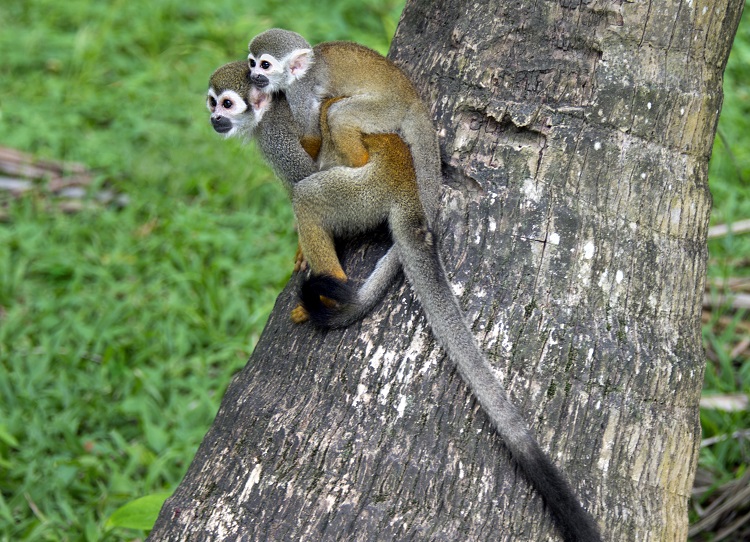
Cooperation studies refer to how these animals help each other and learn in the wild. Studies show that female Squirrel monkeys show disadvantageous inequity aversion. This means they don’t like unfairness (inequity aversion) when receiving less (disadvantageous) food rewards.
In other words, if six apples are available for two monkeys, the females get a bit ticked off if one monkey takes more than its fair share. Apparently, this situation doesn’t bother adult males so much. Scientists say they need more studies to clarify their cooperation behavior.
Color Vision
Humans have two color genes for vision on the X chromosome. One creates a 564 nm wavelength-sensitive pigment, and the other is sensitive to the 534 nm wavelength.
This colour vision is different for Squirrel monkeys. They have one gene on the X chromosome that produces pigment sensitive to three wavelengths – 538 nm, 551 nm, and 561 nm.
Because the males only have one X chromosome, their color vision is dichromatic (color blind) but with various light sensitivities. Females have two X chromosomes with different allele copies. This variation means that some females (1/3) are dichromatic, and some are trichromatic (2/3), like people.
Reproduction
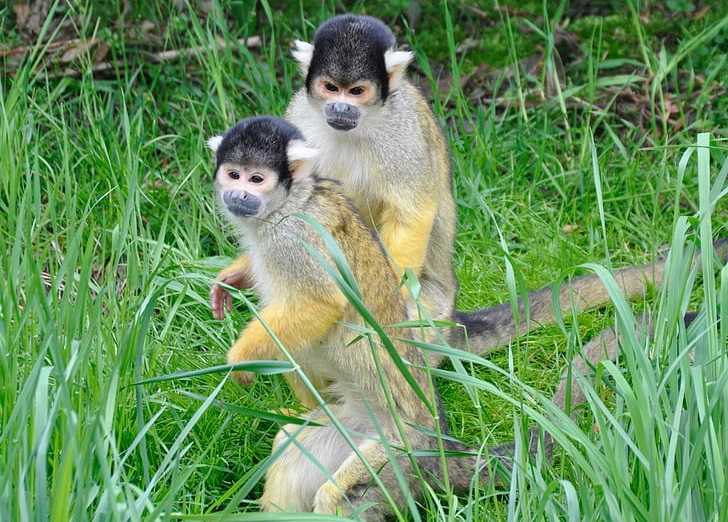
In the world of reproduction, males reach sexual maturity at 2 to 2.5 years. Females become sexually mature at 3 to 5 years. Mating depends on seasonal impacts.
In the breeding season, the male’s shoulders broaden due to increased production of androgen hormones, which peak in January. He fights other males for mating rights. Females also increase in size but not nearly as much as males. They are inclined to pick the biggest males for breeding.
The mother gives birth to one infant following a gestation of 150 to 170 days. Interestingly, this time coincides with the heavy rainfall season between June and August. Only she takes care of her young offspring, carrying the infant on her back within moments after birth.
Weaning times between the species vary from four to 18 months. Thanks to the incredible intelligence of nature, the mother synchronizes this weaning to coincide with an abundance of fruit.
Once the infant reaches about two months, it explores its independence and becomes fully independent at about ten months. Young females remain with their mothers, and males move away to join an all-male group.
Where Do Squirrel Monkeys Live?
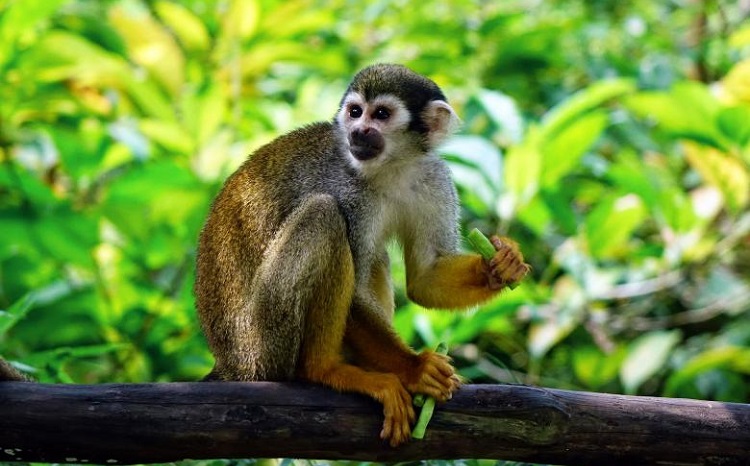
These New World monkeys are native to Central and South America. Their natural habitats are Ecuador and Peru in the northwest of the continent near the Amazon River.
Besides, they also live in Brazil in the east of South America. Other countries where they can be found are Colombia, French Guiana, Guyana, Venezuela, and Suriname. Additional ranges are Panama and Costa Rica in Central America.
Squirrel monkeys’ natural habitat is the rainforest. Here, the tropical lowland climate is hot and humid.
Their ideal living space is in the mid-layer of the forest canopy. They can safely swing among the treetops in large troops. They are also safe where the vegetation is dense and avoid the upper canopy, where they are vulnerable to birds.
Another preference they have is to live near running water, such as a river or stream. These animals also live in other types of forests and near deforested agricultural areas if necessary.
What Does a Squirrel Monkey Eat?
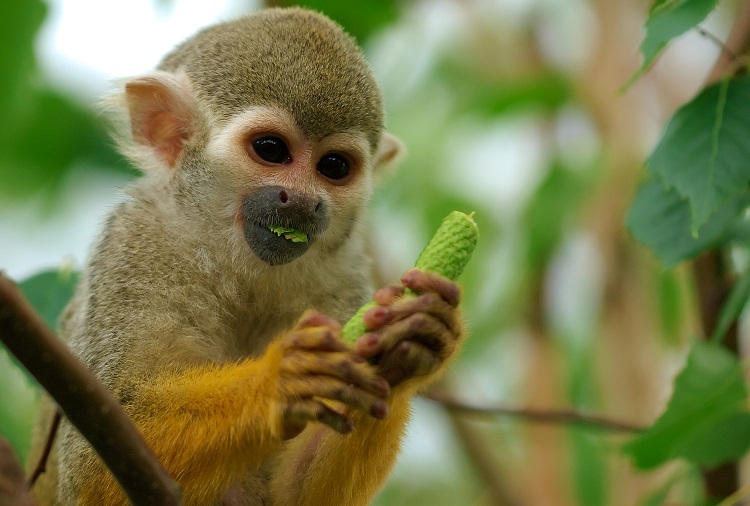
The monkey is an omnivore that is most active during the day. It eats a diverse diet consisting of fruit, nuts, seeds, grains, leaves, insects, and even eggs. Its carnivorous meals comprise delicious small vertebrates like lizards and frogs.
Other delicious treats on the menu are millipedes, spiders, scorpions, and crabs. A typical day of feeding starts with moving through the forest canopy. Once this source is exhausted for the moment, then they move to the ground level to forage further.
Squirrel Monkeys Lifespan
The average lifespan of female Squirrel monkeys in captivity is 27 years. The life expectancy of male Squirrel monkeys in captivity is 22.7 years.
This median is 24.85 for both sexes in captivity. On average, studies show that the life expectancy of this animal in the wild is 21 years. Other sources suggest this timeframe is just 15 years.
Squirrel Monkey Facts
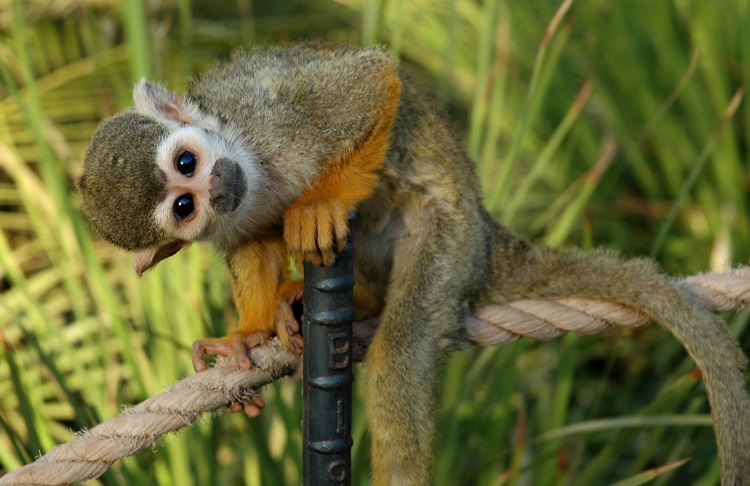
If you haven’t yet learned enough, here are several more interesting facts about Squirrel monkeys:
- They’re cute but can become aggressive pets if you don’t give them enough attention and stimulation.
- Squirrel monkeys have big brains in relation to their bodies. Hence, biologists believe it is the most intelligent New World monkey.
- Squirrel monkeys are diurnal, so they are most active during the day.
- These tiny primates spend 99% of their lives in trees, which is one reason they’re not good pets.
- Their fur has a greenish tint, perhaps from their diet or because of all the time they spend in trees.
- Females have a fake penis. They use it to intimidate juveniles like the males display their dominant behavior.
- A Squirrel monkey named Miss Baker was sent into space in 1959 with Able, a Rhesus macaque monkey. Both returned safely.
Conservation Status
The conservation status of this New World monkey falls into two categories.
The Central American Squirrel monkeys are endangered and are on the IUCN’s vulnerable list. On the same list is the other endangered Squirrel species, the Black Squirrel monkey.
Common Squirrel monkeys or Saimiri sciureus mean that the populations of the other three species are safe from extinction.
Threats to the Saimiri sciureus comprise deforestation, humans, and predators. Other threats include hunting them for the exotic pet trade, illegal hunting, and use in medical research.
Human Interaction
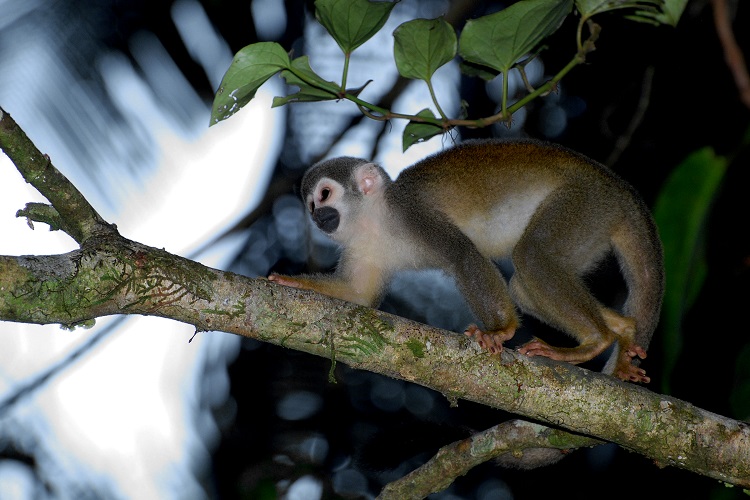
These monkeys became popular pets 50 to 60 years ago for the exotic pet trade because they are so cute. But people quickly found out they are not suitable pets. Here’s why:
- They live in large groups of up to 500 individuals and need to socialize. Pet owners cannot give them this quality of life, even with two Squirrel monkeys.
- In the wild, they freely roam among the trees of the dense rainforest canopy. Pet owners can’t recreate this natural environment.
- It is almost impossible and expensive to try and recreate their diet. Besides, they toss their food around and rub it on everything.
- They throw their poop at you. They also throw objects around if out of the cage.
- Other not-so-endearing qualities include masturbation at any time.
- These primates have an unpleasant smell and use their urine to mark territory.
- Their behavior quickly lands them in animal shelters, which is not their fault.
If this sounds pleasant, you need help. Instead, leave Squirrel monkeys in the wild where they belong and are happy instead of subjecting them to a cruel life in captivity.
FAQs
Do Squirrel Monkeys Have Predators?
Animals that pose a threat to squirrel monkeys are venomous and constricting snakes, felids like big cats, and birds of prey like eagles.
How Much Does a Squirrel Monkey Cost?
In the exotic pet trade, squirrel monkeys can cost from $2,000 to $4,000.
Are Squirrel Monkeys Good Pets?
Squirrel monkeys are not viewed as good pets for the reasons described earlier in this article.
Are Squirrel Monkeys and Common Squirrel Monkeys the Same?
The answer is no. Researchers first thought that these New World monkeys were the same species.
Then, they learned that what they thought was the Common Squirrel monkey was actually four species. Because they look similar, it is difficult to tell them apart. Saimiri scuireus is the Guianan squirrel monkey, which was originally the term for the Common Squirrel monkey containing four separate species.
Conclusion
There is no question that they look like they’d make excellent pets. The truth is that they’re wild animals and need to live in big groups to maintain a healthy social life.
Also, their habitat is vastly different from anything humans can provide. It is cruel to keep them in a cage. Show them you care by not keeping them as pets or encouraging this practice.


